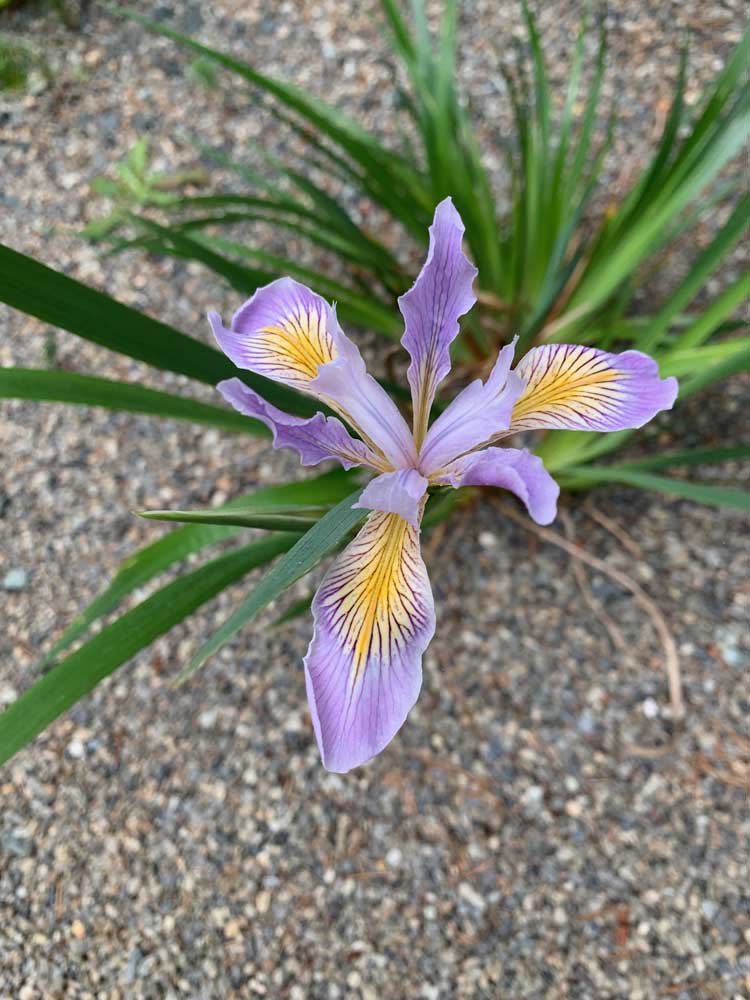GARDEN PLOTS: What is a resilient garden?
Published 7:00 am Wednesday, June 5, 2024

- The author frequently finds evidence of resiliency in her garden. One example is the native iris shown here, Iris douglasiana. It’s one of several iris plants that have managed to push through layers of landscape fabric and gravel in order to establish themselves in an area where there is no competition from weeds.
“The power of nature to survive in challenging conditions is truly inspiring, whether you see a single plant emerging from a crack in a concrete pavement or a contaminated brownfield site full of biodiversity. Nature will adapt to climate change — but the big question is, how will we?”
— Tom Massey, “Resilient Garden: Sustainable Gardening for a Changing Climate,” 2023
When I decided to feature two books focusing on climate change in my column this year, I worried that the information would be repetitive. Back in February, I featured Sally Morgan’s and Kim Stoddart’s book, “The Climate Change Garden” (2023), and discussed some of their recommendations for growing vegetables, heat-tolerant shade trees and orchard trees, as well as dealing with stormwater runoff, under increasingly warmer temperatures and extreme weather.
However, I’ve been hearing and reading lots of weather forecasts lately, which predict another summer of record-breaking temperatures and an especially active hurricane season. The first days of June have already seen extreme heat advisories in California and across the Southwest, and the National Oceanic and Atmospheric Administration has predicted there will be 8 to 13 hurricanes in 2024 (7 is the average) and 17 to 25 named storms (14 is the average).
Nowhere in the media reports is climate change mentioned as the underlying cause of these extreme weather phenomena, nor the fact that we’ve known for decades that more erratic and severe weather will occur as a consequence of global warming. Devastating heat waves, glacier melts, floods, tornadoes and wildfires are all sensationally reported as if they’re unexpected deviations from the norm. People read or listen to these accounts, shake their heads and say, “Isn’t this weather crazy?”
It’s become increasingly clear to me that climate change is yet another issue that many Americans, including elected officials, simply don’t want to face. Big Oil companies spend millions of dollars each year on lobbying efforts and political campaign contributions. Several U.S. senators not only own stocks in Big Oil companies but also sit on committees tasked with environmental protection and climate issues.
Most Americans can’t fathom life without fossil fuel-derived products, particularly electricity, gasoline and plastics. Our addiction to petroleum products makes us all the more susceptible to politically motivated claims that climate change is fake news. Or we throw up our hands in a defeatist attitude and say, “I can’t do anything about it, anyway.”
That’s why I’m no longer concerned that I might repeat myself by discussing some of what landscape designer and climate change activist Tom Massey has to say in his book “Resilient Garden.” We need to hear it again and again, so the planetary and human threat that is climate change doesn’t become lost in the mounting chaos of our times, what some authors have called the “great unraveling.”
Massey uses a three-prong approach to discuss resilient gardens: he presents scientific evidence about climate change, he provides gardening instruction to help mitigate and adapt to climate change, and he interviews several people who manage innovative gardening programs around the world that are addressing climate change right now.
Let’s start by reviewing the basics — what is climate change? As Massey explains, it’s “a fluctuation in longstanding recorded averages of weather patterns,” which are typically taken over a 30-year period. Although the Earth’s tilt can cause the climate to cool down or heat up over millennia, accelerated climate changes we’re seeing today are due to greenhouse gases that are emitted into the atmosphere from human activity, primarily from burning fossil fuels. It’s worth noting that according to NASA, 97% of the climate science community agree that humans are causing global warming in this way.
The buildup of carbon dioxide, methane and nitrous oxide in the atmosphere traps infrared radiation from the Sun, which is absorbed by the Earth’s surface instead of being reflected back into space. According to the 2021 report, “The Physical Science Basis,” issued by the Intergovernmental Panel on Climate Change, unless deep reductions in greenhouse gas emissions are achieved in the next few decades, temperatures will most likely rise 2.5 to 5 degrees C. (4.5 to 9 degrees F.) by the end of the 21st century.
What will this mean? Massey lays it out this way: With even a 2 degree C. increase in global temperatures, about 28% of the world’s population will likely experience an additional month of severe heat stress; 410 million urban dwellers will experience severe drought conditions, impacting water availability in those areas by 2100; the risk of flooding will increase by 170%; sea-level rises will reach 22 inches by 2100, impacting 49 million people; and biodiversity will be further reduced by negatively impacting 8% of the world’s plant species, 6% of insects and 4% of vertebrates.
We’re already experiencing some of these outcomes as the Earth’s surface temperature has increased by 1.1 to 1.3 degrees C. since the mid-1800s. In its August 2023 report, NASA calls the 2 degree rise in global temperatures a “critical threshold, above which dangerous and cascading effects of human-generated climate change will occur.”
Unfortunately, research shows that worldwide carbon emissions from burning fossil fuels actually rose 1.1% in 2023, reaching a record high of 41 billion tons of CO2 emissions. A bit of good news is that U.S. carbon emissions fell 3%, largely due to decreases in burning coal to produce electricity.
Given the current political climate in the U.S. and our slow progress toward reducing greenhouse gas emissions (we’re the world’s leading greenhouse gas emitter behind only China), it’s practically inevitable that we will face the consequences of at least a 2 degree C. rise in global temperatures in the next few decades.
I agree with Massey who says,
“[W]e are at a point now where we cannot completely alleviate the effects of climate change. We will need to adapt, finding new ways to build resilience and cope with threatening prospects worldwide.”
So I will end this column with the same question I posed as the title — What is a resilient garden? I’ll explore Massey’s ideas about this in the coming weeks, but for now I can say a resilient garden is not only a planted space that’s able to cope with threatening climatic prospects but also one that will enable gardeners to make a small but collectively impactful difference in human-driven climate change.









